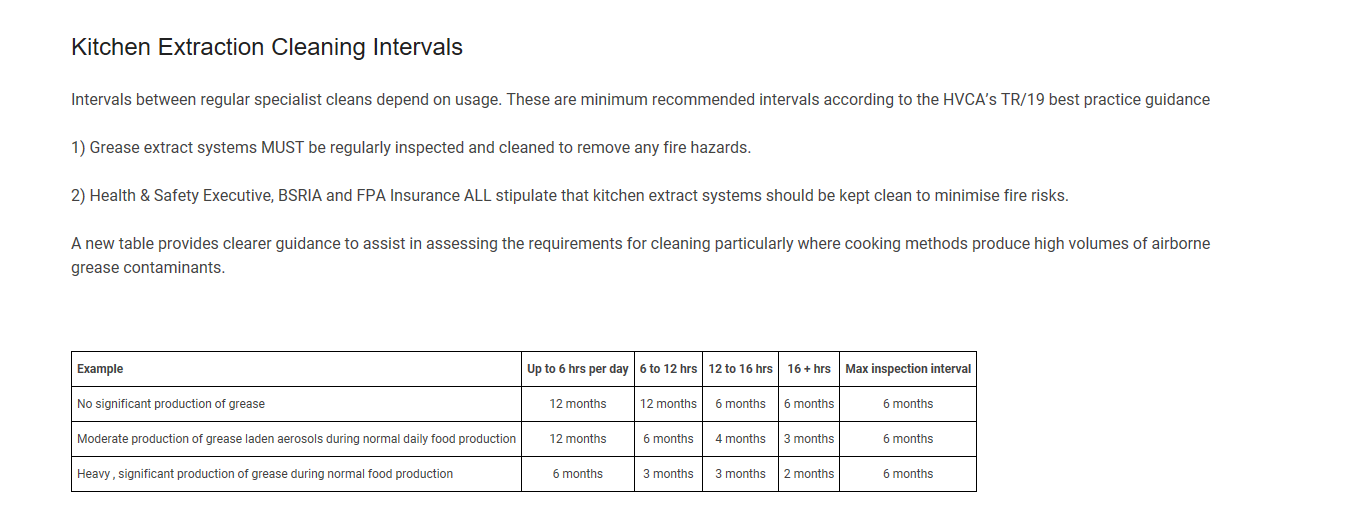Guide to Good Practice: Internal Cleanliness of Ventilation Systems
PdC is committed to ensuring that our cleans are carried out to the highest standards, and as such we consider the TR/19 Guide to Good Practice to be one of the mainstays of our approach to quality.
Here is a bit of background to the standard which you may find helpful.
In 2005 the then HVCA amalgamated two publications (TR/17 and DW/TM2) to produce the TR/19, which incorporates the best practice for installing new systems and maintaining them and allows specifiers to deal with all aspects of the duct system in one publication.
TR/19 is ideal for use by specifiers, consultants and building legislators to ensure that ventilation systems are properly maintained. It is especially important for kitchen ventilation due to the elevated risk of grease deposits in extract systems, which can lead to fires. Adherence to the standards in TR/19 will provide detailed, recognised proof that the ventilation system in a building is safe and well maintained, which is vital for securing insurance policies.
The guide includes further improvements to best practice standards with particular reference to kitchen extract systems. According to Gareth Keller, Head of the Heating Ventilating Contractors’ Association’s Specialist Group Services department: “As the bar for indoor air quality standards is raised, the industry is actively seeking guidance.
TR/19 draws on the extensive experience of HVCA members and has been written to meet this need, providing high-
Everyone has the right to healthy indoor air. Therefore, it is vital we do everything in our power to ensure optimum indoor air quality. The proper maintenance of ductwork and ventilation systems is paramount in this and I am positive that the guidance in TR/19 will provide a great resource for the industry at this important time.”
TR19 Guide to Good Practice
Recent Revisions to TR/19
The Building and Engineering Services Association has recently updated the “Guide to good practice – internal ventilation systems” [TR19]. It is almost 10 years since the previous update, and in that time we have seen ever more stringent levels of ventilation-
There are two key factors driving this requirement;
Increased awareness of and concern for internal air pollution and its impact on building occupants.
Fire risk from grease build up in kitchen extract systems, which is linked to an alarming number of fires every year in non-
Read more about this in an article by Richard Norman, Chairman of the ventilation hygiene branch of B&ES.
How clean and safe is your ductwork?

Standards & Legislation
Standards and Quality assurance are fundamental to System Hygienics. As the UK's market leader we have been at the forefront of raising standards.
The BS EN 15780:2011 clearly defines the cleanliness to be achieved by anyone responsible for the ventilation in any building by recognising that different building uses require different standards and that newly installed ductwork should be handed over in a measurably clean condition.
All our work is carried out to the latest B&ES TR19 (2nd edition: 2013) standards which provide recognised levels of cleanliness which is confirmed by independent laboratory testing.
The Workplace Health, Safety & Welfare Regulations 1992 have been updated in 2013 and give detailed advice on an employer's responsibilities relating to workplace health and safety. It stipulates that: "Mechanical ventilation systems (including air conditioning systems) should be regularly and adequately cleaned. They should also be properly tested and maintained to ensure that they are kept clean and free from anything which may contaminate the air".
The Regulatory Reform(Fire Safety) Order 2005 gives building owners and managers clear legal responsibility on their duty of care with regard to the maintenance of fire safety systems and what is required in regard to the essential maintenance of fire dampers. It is also an important reinforcement of the duties of responsible persons regarding kitchen extract system cleanliness. This is in addition to their normal insurance contract requirements.
The Health Technical Memorandum 03-
Smith Services Duct cleaning : Maintenance Service > Ventilation and Ductwork Cleaning
SMITH SERVICES LTD
THE DUCT CLEANING EXPERTS
MOB: 07947730858 OFFICE: 01734447555 www.smithservicesduct.co.uk